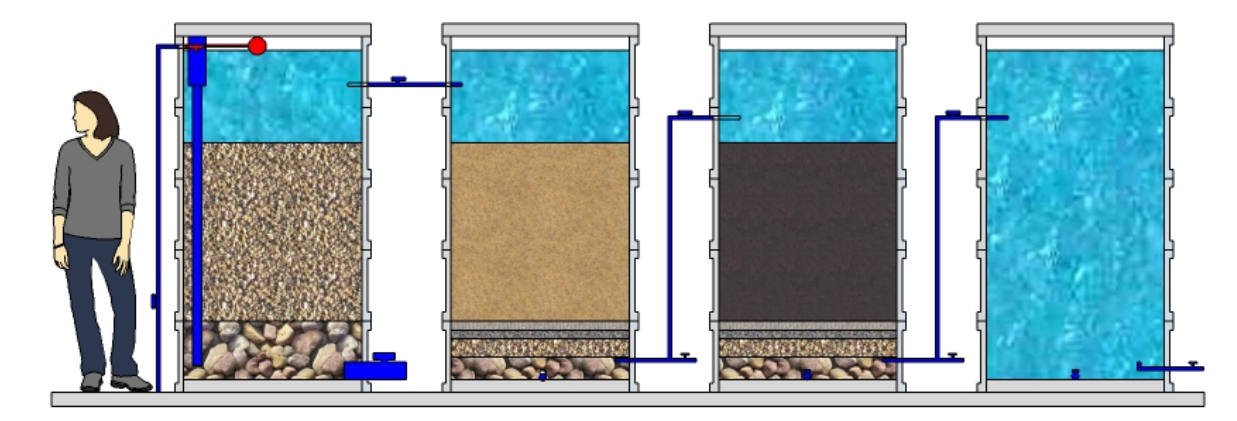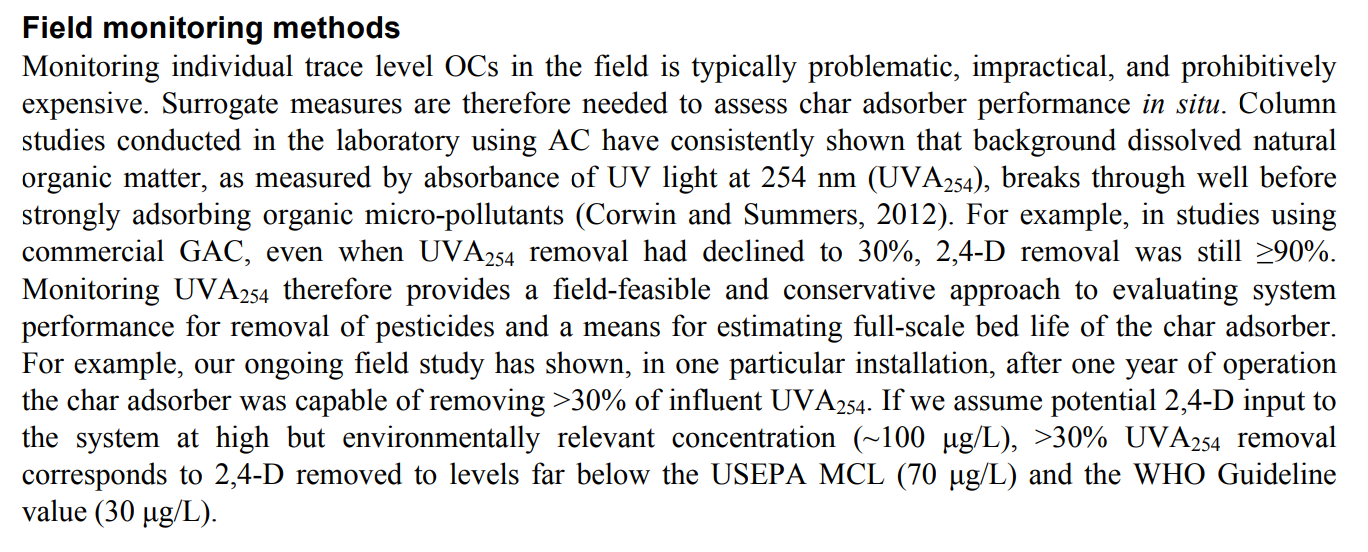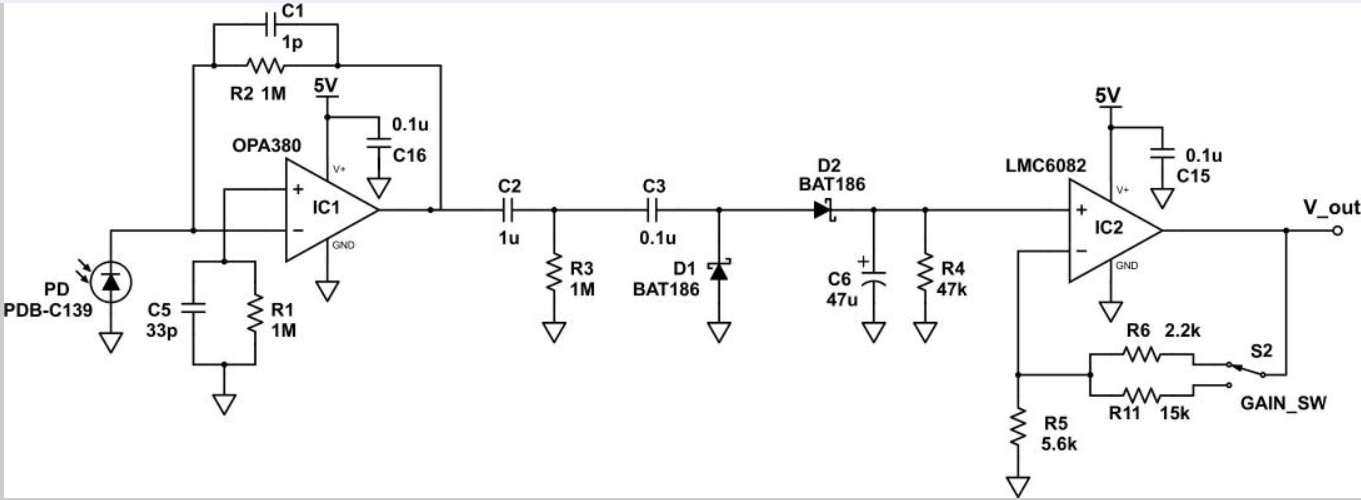Edge Collective
Biochar Water Filters
DIY techniques for filtering contaminants from drinking water, based on the designs by Aqueous Solutions and the work of Dr. Josh Kearns.Biochar and Decentralized Water Filtration
 |
|---|
| A community water filtration system that includes a final 'biochar' stage, from a Kearns et al 2016 Presentation on Biochar and water filtration |
 |
|---|
| A 10 liter biochar-based water filter as depicted in 2023 paper by Kearns et al, 'Adaptable Community Particaptory Design...', Water Security 2023 (local; online) |
Why decentralized water filtration?
Gaining access to clean drinking water is increasingly more difficult, around the world. Microbial contaminants, chlorination by-products, and pesticides are growing problems everywhere.
Because chlorine helps to keep water safe from potentially harmful bacteria, water engineers typically design centralized water systems to maintain a chlorine residual in the water that is distributed to households. This chlorine often interacts with organic matter in distribution pipes to produce some concentration of toxic chlorination by-products in the water delivered to homes; but this is typically viewed as an acceptable trade-off, as long as these concentrations are low. (The Florida Health Department has a useful document on the regulation of trihalomethanes in drinking water).
Further: centralized water treatment infrastructure is dependent on a well-functioning electrical grid for its operation, the anticipated increasing frequency and severity of grid disruptions due to climate change will likely render centralized drinking water systems increasingly vulnerable to extended disruptions.
For these reasons there has been a growing interest in developing solutions for clean drinking water at the local community or household level.
Why biochar?
One common technology for the removal of contaminants from water is the use of activated carbon as a filter. As water passes through such a filter, contaminatns are adsorbed to the carbon in the filter and removed from the water.
Such carbon filters only have a limited capacity for adbsoprtion, and therefore must be replaced after a certain amount of use. Their cost is not trivial; so a household or small community using such filters for their drinking water will incur an ongoing cost. Also, traditional methods for producing activated carbon typically rely on sophisticated industrial chemical processes and fossil fuel-based inputs.
Research in the last decade has indicated that biochar, when produced at sufficiently high temperatures, can serve in large part as a replacement for standard activated carbon filters.
Such biochar filters can be produced from a wide variety of biomass materials -- including common agricultural waste -- using equipment that can be manufactured locally from widely-available materials (some designs use two 55 gallon steel drums).
How can we know whether the filter is effectively removing contaminants of concern?
A typical approach to testing the effectiveness of any filtering method is to conduct a laboratory test for the levels of contaminants of concern in the water before and after passing through the filter.
The challenge when working outside of academia, industry, or government is that such laboratory tests, even for a single contaminant, can be very costly -- on the order of $100 or more per sample. Multiple tests to assess multiple contaminants, initial filter effectiveness, and ongoing filter effectiveness are therefore often infeasible.
Kearns et al have been working to develop lower-cost methods of testing that leverage a particular feature of biochar (and similar filters): some contaminants adbsorb much more easily than others. It turns out that the presence of one class of more weakly-adsorbed contaminants -- dissolved organic matter -- is relatively easy to assess with a lower-cost laboratory method: UV spectrophotometry.
The details of this approach are laid out in a 2020 article by Kearns et al:
- "Biochar Water Treatment for Control of Organic Micropollutants with UVA Surrogate Monitoring" -- https://www.liebertpub.com/doi/full/10.1089/ees.2020.0173 | PDF | local PDF
And specific instructions for performing the UV absorbance test are laid out in the supplementary section, here:
Further: while commercial UV spectrophotometers used in such tests are usually over $2000, there are several designs available for DIY forms of the instrument, costing under $100 in parts. We found one design to be particularly simple and well-characterized:
- "An accurate, precise, and affordable light emitting diode spectrophotometer for drinking water and other testing with limited resources" -- https://www.ncbi.nlm.nih.gov/pmc/articles/PMC6988917/
Our aim is to build a working prototype of this UV spectrophotometer, compare its performance to similar commercial instruments used in a laboratory, and then see if such an instrument might be easy to build and use in a community workshop setting.
Well-documented designs for biochar-based water filtration systems
Dr. Josh Kearns (UNC) has led efforts in the last decade to assess the ability of biochar to filter out various water contaminants such as pesticides and chlorination by-products, and has developed designs that have now been built and used by communities around the world. His team has produced manuals in several langauges for constructing water filtration systems.
Kearns and his collaborators have formed a non-profit, Aqueous Solutions, to disseminate their work. Manuals, instructional videos, and peer-reviewed research are avaiable on their "Charcoal / Biochar water treatment" page.
Their designs include water filtration systems with capacities that range from small household use (300 liters or less) to larger-scale community use (2000 liters or more).
Manuals:
- Building a 2000 liter per day water treatment system (pdf): in English
- Building a 300 liter per day water treatment system (pdf): in English | in Spanish
An elegant overview of the design of a biochar-based water filtration system
A researcher in Thailand describes a system design that has since been widely reproduced throughout Thailand and the region.
Kearns et al Biochar Water Treatment academic presentation
A nice history and overview of the project.
(Slides from the above presentation)
Construction of a biochar gasifier
In the below video, Kearns demonstrates a simple design for a biochar gasifier which is capable of operating at the high temperatures required to produce biochar that is effective for water filtration:
A simplified design using only hand tools, mud, and two oil drums is described here:
A small-scale gasifier for testing and development
In the below video, Kearns describes the project while demonstrating a smaller-scale version of a biochar gasifier:
Water testing for disinfection byproducts
Simple Labs offers useful information on disinfection byproducts in drinking water and offers a VOC Water Test for $140.
Miscellaneous notes
-
Kearns et al 2015 suggest that MIB content in water, detectable by human nose at low levels, might be a DIY way of indicating exhaustion of biochar material.
-
EPA method used in Kearns et al 2015 to assess TTHMs: https://www.epa.gov/sites/default/files/2015-06/documents/epa-551.1.pdf

-
Steel drums avail on Amazon: https://www.amazon.com/Vogelzang-DR55-Gallon-Barrel-Stove/dp/B000VHDSJM/
-
Steel drums avail locally https://rochedrums.com/
Further References
https://www.echocommunity.org/en/resources/f9592532-c0cd-424f-81d5-80444d693a2c
https://www.echocommunity.org/en/resources/80473b4a-5680-4648-9d81-a0027a7d92b7
Sat Dec 16 09:49:09 PM EST 2023
Solar biochar:
https://www.solarpaces.org/designing-solar-furnaces-to-make-biochars-without-air-pollution/
On permies:
https://permies.com/t/156942/Biochar-Solar-Kiln
Tue Jan 30 03:18:34 PM EST 2024
activated carbon experiment https://www.sciencebuddies.org/science-fair-projects/project-ideas/Chem_p108/chemistry/which-filtration-material-leads-to-the-best-drinking-water
SEM analysis of activated carbon https://www.researchgate.net/publication/234060484_Performance_of_activated_carbon_in_water_filters -- mentions THM.
https://www.youtube.com/watch?v=BtLAHLflngY -- Methylene-blue is a standard proof of performance
"High adsorption capacity of phenol and methylene blue using activated carbon derived from lignocellulosic agriculture wastes" https://www.nature.com/articles/s41598-022-09475-4
"Optimizing biochar adsorption relative to activated carbon in water treatment" https://www.sciencedirect.com/science/article/abs/pii/B9780128222256000166 -- huge article, and journal!
Scott Summers @ UC Boulder https://www.colorado.edu/even/r-scott-summers
" Biochar technology in wastewater treatment: A critical review" -- https://www.sciencedirect.com/science/article/abs/pii/S0045653520307323#:~:text=Biochar%20can%20be%20used%20as,organic%20contaminants%2C%20nitrogen%20and%20phosphorus.
"Recent advances in biochar application for water and wastewater treatment: a review" https://www.ncbi.nlm.nih.gov/pmc/articles/PMC7243815/
"https://www.sciencedirect.com/science/article/abs/pii/S030147971730302X" https://www.sciencedirect.com/science/article/abs/pii/S030147971730302X
Great collection of papers comes up here: https://www.google.com/search?q=low-cost+assessment+of+biochar+adsorption+water+treatment&oq=low-cost+assessment+of+biochar+adsorption+water+treatment&gs_lcrp=EgZjaHJvbWUyCQgAEEUYORigATIHCAEQIRigAdIBCTE0MTU1ajBqN6gCALACAA&client=ubuntu-chr&sourceid=chrome&ie=UTF-8
UVA Surrogate monitoring! https://www.liebertpub.com/doi/full/10.1089/ees.2020.0173
"Leveraging DOM UV absorbance and fluorescence to accurately predict and monitor short-chain PFAS removal by fixed-bed carbon adsorbers" https://www.sciencedirect.com/science/article/abs/pii/S0043135422001099
UV 254 https://cfpub.epa.gov/si/si_public_record_Report.cfm?Lab=ORD&dirEntryID=46892
https://www.hach.com/p-dr6000-uv-vis-spectrophotometer-with-rfid-technology/LPV441.99.00012
"A quick test method for predicting the adsorption of organic micropollutants on activated carbon" https://www.sciencedirect.com/science/article/abs/pii/S0043135422011629
uv254 realtech https://pentairaes.com/real-tech-uv254-field-meter
uv sensors! https://www.sparkfun.com/news/8955
datasheet for uv sensor https://cdn.sparkfun.com/assets/b/8/6/d/2/AS7331_DS001047_4-00.pdf?_gl=11vp17xj_gaMTAxODA3MzExMC4xNzAyMzMxMzQx_ga_T369JS7J9N*MTcwNjY1MDM1MC41LjEuMTcwNjY1MDQxMS42MC4wLjA.
"uv254nm is an excellent surrogate parameter" https://www.jstor.org/stable/41272390
"UV254 absorbance as real-time monitoring and control parameter for micropollutant removal in advanced wastewater treatment with powdered activated carbon" https://pubmed.ncbi.nlm.nih.gov/26963606/
Good review of UV254 -- https://assets.thermofisher.com/TFS-Assets/LPD/Application-Notes/UVA%20Measurements%20App%20Note%20033%20AN-UVMEASUREMENTS-E%20Rev%20A%201020%20Web.pdf
Quartz cell for spectrophotometer -- $10 ea -- https://www.amazon.com/QWORK-Cuvettes-Absorption-Spectrometer-Absorbance/dp/B085VWLRTB/ref=pd_day0_d_sccl_3_2/137-3207617-0578052?pd_rd_w=GXI6p&content-id=amzn1.sym.8ca997d7-1ea0-4c8f-9e14-a6d756b83e30&pf_rd_p=8ca997d7-1ea0-4c8f-9e14-a6d756b83e30&pf_rd_r=GAQNCADP0ZFG2CQY7M3J&pd_rd_wg=8nbdQ&pd_rd_r=ed726004-4614-43a8-8d25-4f57dab17e20&pd_rd_i=B085VWLRTB&th=1
Guide to cuvettes: https://spectrecology.com/blog/guide-to-cuvettes/
Board design for a spectrophotometer https://github.com/HemanthSabbella/pointSpectra
pdf of kearns et al 2020 biochar uva surrogate monitoring
 |
|---|
| via Kearns 2014 |
"Leveraging DOM UV absorbance and fluorescence to accurately predict and monitor short-chain PFAS removal by fixed-bed carbon adsorbers"
https://pubmed.ncbi.nlm.nih.gov/35167965/
Note on logic here:
- DOM fouling is a primary mechanism responsible for reducing biochar filter effectiveness
- UV254 is a reliable way of detecting presence of DOM
But are DOMs useful sentinels, too?
"Evaluation of Two Real Time Methods for Assessing THM Precursor Concentrations" https://scholarworks.umass.edu/cgi/viewcontent.cgi?article=1100&context=cee_ewre
https://www.linkedin.com/in/griffin-moriarty-632bb2a9/
"A review of mechanism and adsorption capacities of biochar-based engineered composites for removing aquatic pollutants from contaminated water" https://www.frontiersin.org/articles/10.3389/fenvs.2022.1035865/full -- useful re: ability of biochar to handle various contaminants -- interesting that 'fast' pyrolosis and 'slow' pyrolosis yield filters optimized for different contaminants
"internally modified pyrolysis" -- a way of improving biochar characteristics -- https://link.springer.com/article/10.1007/s44246-022-00007-3
Nice review of using activated carbon filters: https://extensionpublications.unl.edu/publication/g1489/pdf/view/g1489-2013.pdf
'what is dissolved organic matter' https://www.usgs.gov/labs/organic-matter-research-laboratory/what-organic-matter-0
"A Layman’s Guide to Inorganic and Organic Contaminant Removal by Standard Filtration Methods" https://shelco.com/wp-content/uploads/2020/02/A-Laymans-Guide-to-Inorganic-and-Organic-Contaminent-Removal-by-Standard-Filtration-Methods.pdf
UV254 hardware
General notes on spectrophotometers:
https://scienceinfo.com/single-beam-spectrophotometer-limitations/
"Viking Spectrophotometer: A Home-Built, Simple, and Cost-Efficient Absorption and Fluorescence Spectrophotometer for Education in Chemistry" https://pubs.acs.org/doi/10.1021/acs.jchemed.2c00679
J Feng and H King https://www.hardware-x.com/article/S2468-0672%2821%2900071-7/fulltext
"3D-Printable and open-source modular smartphone visible spectrophotometer": https://www.sciencedirect.com/science/article/pii/S2468067221000614
"An Open-Source, Miniature UV to NIR Spectrophotometer for Measuring the Transmittance of Liquid Materials" https://www.researchgate.net/publication/359086459_An_Open-Source_Miniature_UV_to_NIR_Spectrophotometer_for_Measuring_the_Transmittance_of_Liquid_Materials -- seems like an easy place to start!
DIY Nanodrop (with lasercut parts): https://hackteria.org/wiki/DIY_Microvolume_Spectrophotometers
"A 3D-Printable Dual Beam Spectrophotometer with Multiplatform Smartphone Adaptor" https://par.nsf.gov/servlets/purl/10148685
"An accurate, precise, and affordable light emitting diode spectrophotometer for drinking water and other testing with limited resources" Most relevant design thus far! https://www.ncbi.nlm.nih.gov/pmc/articles/PMC6988917/ <--- this is a beautiful paper to emulate!
Detector
Photodiode: https://mm.digikey.com/Volume0/opasdata/d220001/medias/docus/318/SD008-2171-112.pdf
Sparkfun breakout board for AS7331: https://www.sparkfun.com/products/23517?gad_source=1&gclid=CjwKCAiA_OetBhAtEiwAPTeQZ0rMOYJ3sqizSce7bVOrrJUFEMaHffxDSub0H7Rq_2bmHRRj6onYZxoCM0IQAvD_BwE
Associated AS7331 sensor chip datasheet https://www.digikey.com/en/products/detail/ams-osram-usa-inc/AS7331-AQFM-OLGA16-LF-T-R/16983751
Emitter
LED https://www.digikey.com/en/products/detail/inolux/IN-C35PPCTGU0/16965314
Key papers 02/02/23
"An accurate, precise, and affordable light emitting diode spectrophotometer for drinking water and other testing with limited resources" -- https://www.ncbi.nlm.nih.gov/pmc/articles/PMC6988917/
 |
|---|
| Power circuit in Prairie et al 2020 |
 |
|---|
| Emitter circuit in Praire et al 2020 |
 |
|---|
| Detector circuit in Prairie et al 2020 |
"Biochar Water Treatment for Control of Organic Micropollutants with UVA Surrogate Monitoring" -- https://www.liebertpub.com/doi/full/10.1089/ees.2020.0173 | PDF | local PDF
Main questions
- How might we assess the performance of a given batch of biochar in an accessible way?
- Does UVA254 work to assess initial performance of a filter?
- Could we e.g. introduce some DOM into tap water, see that UVA254 is lower after biochar filter, and conclude that the filter is blocking DOM as well as more weakly-adsorbed micropollutants?
- Could we create some DOM-based 'standards' using distilled water and some easy-to-obtain substance, in order to assess a biochar filter and/or calibrate a DIY UVA254 instrument?
Notes on UV254
Realtech guide https://realtechwater.com/blog-post/what-is-uv254/
Explanation of units for 'absorbance per path length' https://realtechwater.com/parameters/uv254/#:~:text=Ultraviolet%20light%20at%20the%20254,length%20(abs%2Fcm).
Thermoscientific guide https://assets.thermofisher.com/TFS-Assets/LPD/Application-Notes/UVA%20Measurements%20App%20Note%20033%20AN-UVMEASUREMENTS-E%20Rev%20A%201020%20Web.pdf
Nice explanation of Beer-Lambert Law https://chem.libretexts.org/Bookshelves/Physical_and_Theoretical_Chemistry_Textbook_Maps/Supplemental_Modules_(Physical_and_Theoretical_Chemistry)/Spectroscopy/Electronic_Spectroscopy/Electronic_Spectroscopy_Basics/The_Beer-Lambert_Law
Standard method suggests that results should be reported at a pH of 7? https://www.eraqc.com/content/files/PDFs/instructions/662-uv-254-absorbance-crm-en.pdf
Sun Feb 4 08:47:50 PM EST 2024
Test methods for activated carbon -- p19 suggests testing one activated carbon filter against another known filter in terms of relative adsorption -- this could be a method for assessing biochar
Suggestion here -- try filtering tea or coffee.
Industry standard tests for activated carbon here: includes Iodine adsorption test; chlorine removal test.
UV and Fluorescence paper mentioned by Kearns et al: Sgroi et al 2018, "Modeling emerging contaminants breakthrough in packed bed adsorption columns by UV absorbance and fluorescing components of dissolved organic matter"
Nice references at the end of this diy fluorometer lab
Arduino-based fluorometer for DNA analysis
Improvements in LED-based fluorescence analysis system
DEVELOPMENT OF A LOW COST LED-PHOTODIODE BASED SPECTROPHOTOMETER FOR CONTINUOUS ON-LINE MONITORING USING OPTICAL FLOW CELLS -- looks like a really nice report, with explanation and overview
Diode array versus filter-based spectrometers
Inexpensive, Open Source Filter Fluorometers for Measuring Relative Fluorescence -- nice overview and background explanation
Interesting idea -- perhaps a 'filter fluorometer' might allow for a local / DIY light sources?
A novel low-cost plug-and-play multi-spectral LED based fluorometer, with application to chlorophyll detection -- 2023 paper, interesting design
Design of a Portable and Reliable Fluorimeter with High Sensitivity for Molecule Trace Analysis -- 2023 paper
Portable Fluorescence Spectrometer for Measuring Water Quality -- nice senior project, with background references
02/16/24
great note from Thermo on uv254 4m
uv calibration standard methods
[uv method suggesting passing through 0.45 um filter](file:///home/db/Downloads/METHOD_415.3_REV1.2_FINAL.PDF)
"potassium hydrogen phthalate (KHP)"
preparing a standard KHP solution
02/28/24
PFAS and activated carbon:
- PBS Wisconsin, "What should I do about PFAS in my water?"
Granular activated carbon systems, generally the least expensive treatment option, can remove some PFAS, including PFOA and PFOS. They work by binding PFAS to a porous carbon surface. But molecularly shorter chemicals, known as short-chain PFAS, may slip by. You can install the filter as a household unit or in sinks, faucets, refrigerators and pitchers. Ion exchange resins act like little magnets that capture PFAS molecules. They are generally more effective than activated carbon, especially at snatching short-chain PFAS. Both technologies often cost less than reverse osmosis systems, which can run upwards of $1,000 to $2,000. Reverse osmosis devices force high-pressure water through a membrane with small pores to separate chemicals, including short-chain PFAS, from water. However, the technology requires a large volume of water, and it discharges PFAS-tainted backwash into sewer or septic systems — potentially reintroducing the contaminants into the environment.
- EPA, "Reducing PFAS in Drinking Water with Treatment Technologies"
- EPA, "Technologies for Reducing PFAS in Drinking Water"
- Riegel et al., "Sorptive removal of short-chain perfluoroalkyl substances (PFAS) during drinking water treatment using activated carbon and anion exchanger"
Laboratory tests and column tests were carried out in a waterwoks to investigate the removal of short- and long-chain PFAS using activated carbon filtration and ion exchange treatment. For all adsorbents, the sorption affinity of short-chain per- and polyfluoroalkyl carboxylic acids (PFCA) was significantly lower than that of long-chain PFAS or short-chain per- and polyfluoroalkyl sulfonic acids (PFSA). In the PFAS-polluted groundwater matrix, the short-chain PFCA PFBA and PFPeA could only be sufficiently removed with activated carbon over short run times of 6000 and 11,000 bed volumes (BV), respectively. Longer PFCA with a chain length of C6 or more were removed over longer run times. The removal of short-chain PFCA using ion exchange media could also only be achieved over relatively short run times of 5000 BV for PFBA, 10,000BV for PFPeA and 18,000 BV for PFHxA. These are sometimes significantly longer than those of activated carbon. Due to the higher material costs for ion exchange media, there are nevertheless no lower operating costs when the ion exchangers are used in single-use mode. However, ion exchangers can be regenerated and then reused which can result in economic advantages compared to activated carbon filtration. However, for the extensive regeneration, especially for the elution of the long-chain PFAS, the additional use of ethanol is needed in the process. In contrast, the short-chain PFBA and PFPeA can be extracted without organic solvent from a weakly basic ion exchanger.
Activated-carbon filters removed 73% of PFAS contaminants, on average, but results varied greatly. In some cases, the chemicals were completely removed; in other cases they were not reduced at all. Researchers saw no clear trends between removal efficiency and filter brand, age or source water chemical levels. Changing out filters regularly is probably a very good idea, nonetheless, researchers said.